Interview
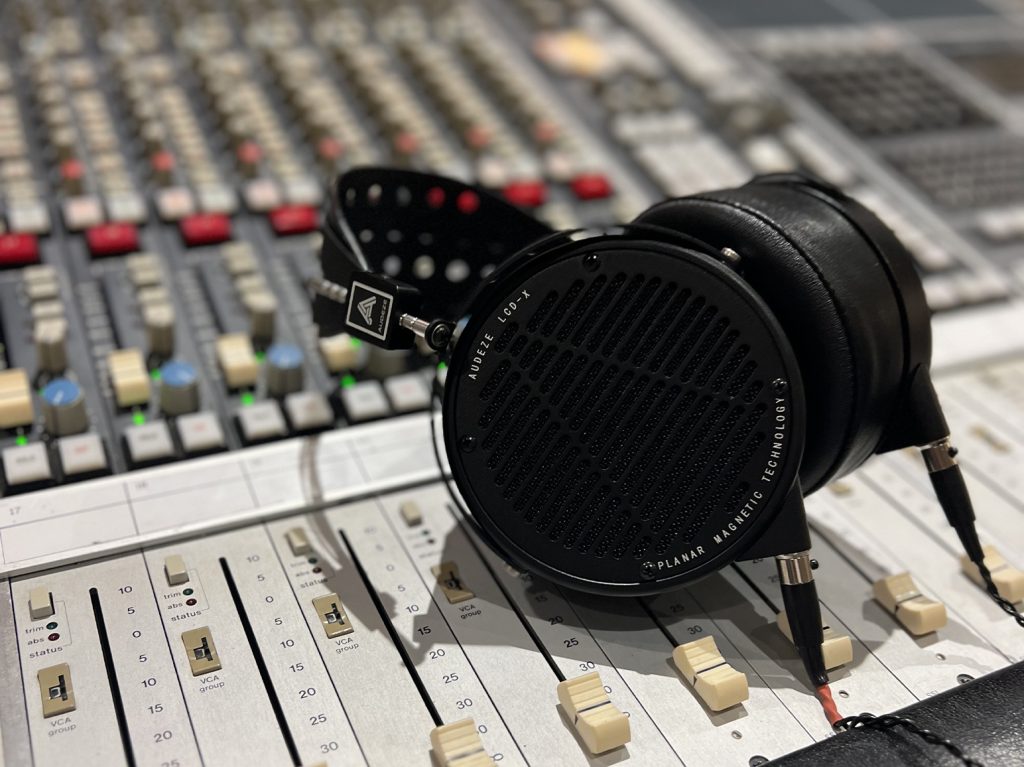
Talking to Audeze: Chris Berens
Audeze, founded in 2008, is a renowned audio company known for revolutionising headphone technology. Their commitment to exceptional sound quality and innovative designs has earned them a stellar reputation among audiophiles and professionals. As part of our recent partnership, we spoke to Chris Berens, head of Artist Relations at Audeze, about his background, the company’s history and what sets their products apart from the competition.
- To begin with can you tell us a little about your background – where did your career start and how did you first become interested in the world of audio gear?
I’ve been a music lover all my life. I grew up with an audiophile dad who also played trumpet, and my mom was a drummer in the jazz and marching bands in high school and college. As a kid I recall wanting to play guitar and drums at a very young age, then in my early teens when hiphop broke I got a couple turntables and a Radio Shack mixer and started to record things to my boombox (mostly noisy crap, a habit that still continues to this day haha). I remember in my late teens my dad handed me down some lovely hifi speakers (Vandersteen IIcs, my first floor standers with big woofers), which I thought would make a way better bass amp than my little Ampeg…. I played about 3 notes before the speakers blew out and that was my first real exposure to the differences between home hifi and pro audio gear!
Fast forward to college, and the art school I attended (San Francisco Art Institute, RIP) had a film program with a sound class, which I took advantage of to make more dodgy recordings in higher fidelity with some of my friends. Several bands, production gigs and “dad jobs” later, I started at Audeze in 2016, running the customer support department, which turned into full-time artist relations in 2020 as I’d started to build relationships with some of the artists that constantly seemed to be contacting us. Since then I’ve been very fortunate to visit some truly amazing studios, hang with wonderful creative people, and be somewhat involved in the product development side providing feedback from those adventures.
- What inspired the founding of the company?
Audeze’s founders were four guys: Sankar and Dr. C, both still with the company and very active, plus two guys no longer actively involved named Alex and Pete. Sankar came from the high end movie camera and code-writing worlds and is currently our CEO, Dr C is our CTO and is THE preeminent planar magnetic driver expert in the world, Alex was connected to the music/production industries and was instrumental in seeding our original headphones to the pro community, and Pete was responsible for the original flexible circuit material we started using for diaphragm film (and he still runs that same company). Basically, they started by looking at ways to make big planar speaker arrays for public address – one of which still lives in our facility – and then shifted to headphones when they discovered that the film made a nearly ideal single-driver for headphones. After many prototypes (and at least twice as many beers), the first pairs of LCD-2s were brought to an audio show called Rocky Mountain Audio Fest in 2009, where they were hugely successful. From there we just kept pushing to make things better, and we still do.
A little story about how the company name came about: Audeze was started in 2008 in a garage in Southern California, when the four founders wanted to pursue a “journey through audio.” On the wall of the garage was a 2001: a Space Odyssey movie poster, which became the inspiration for how Audeze was named: changing the spelling to reference AUDio, and the EZE part was probably suggested by the beer! So we say Ah-deh-Zee, but you can pronounce it however you want, as long as you use the cans. 😉
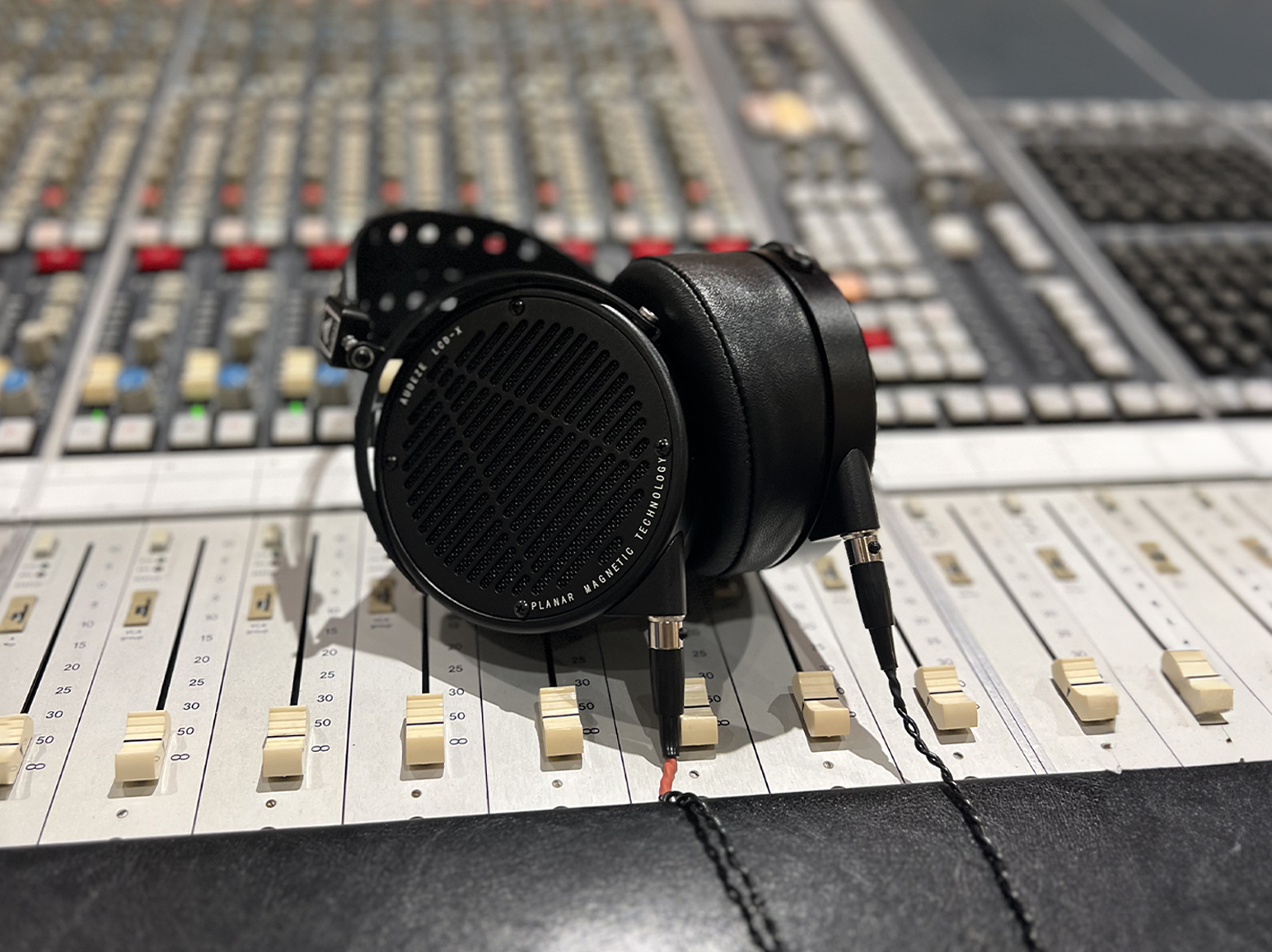
- What do you believe sets you apart from other companies offering similar products?
Absolutely without a doubt: our unique technology! There are other companies making planar magnetic headphones out there of course, but none of them do things like we do. First off, we use some of the thinnest film in the industry to make our diaphragms (either 1.8 or 0.5 microns, thinner than a blood cell!), which makes for very fast transient response and very low distortion. On top of that, we have several patents on the way we make our drivers, including: Fluxor magnets which focus a huge amount of magnetic power on the diaphragms for greater control over movement; Fazor elements which help maintain phase coherency, imaging accuracy, and increased treble extension; and Uniforce voice coils that equalize the magnetic force on the diaphragm for even lower distortion. I could go on with other stuff (not even mentioning our electrostatic innovations yet, but see below). Anyone interested in this nerdy stuff should check out our fun and informative tech articles:https://www.audeze.com/blogs/technology-and-innovation
- Which models are you most proud of to date and why?
I’ll pick three for pro audio:
- The ground-breaking LCD-X https://www.audeze.com/products/lcd-x which was the first model that made mix engineers say “I can mix on headphones!”
- The next-generation LCD-5 https://www.audeze.com/products/lcd-5 that shone a new light on inner details and brought comfort to a new level.
- The amazing CRBN electrostatic https://www.audeze.com/products/crbnwhich I lovingly call our “mastering headphone” because people like Tony Cousins, Bob Ludwig and Bob Katz have come to rely on them. (BTW, these are also my personal favorite cans, I listen to them daily.)
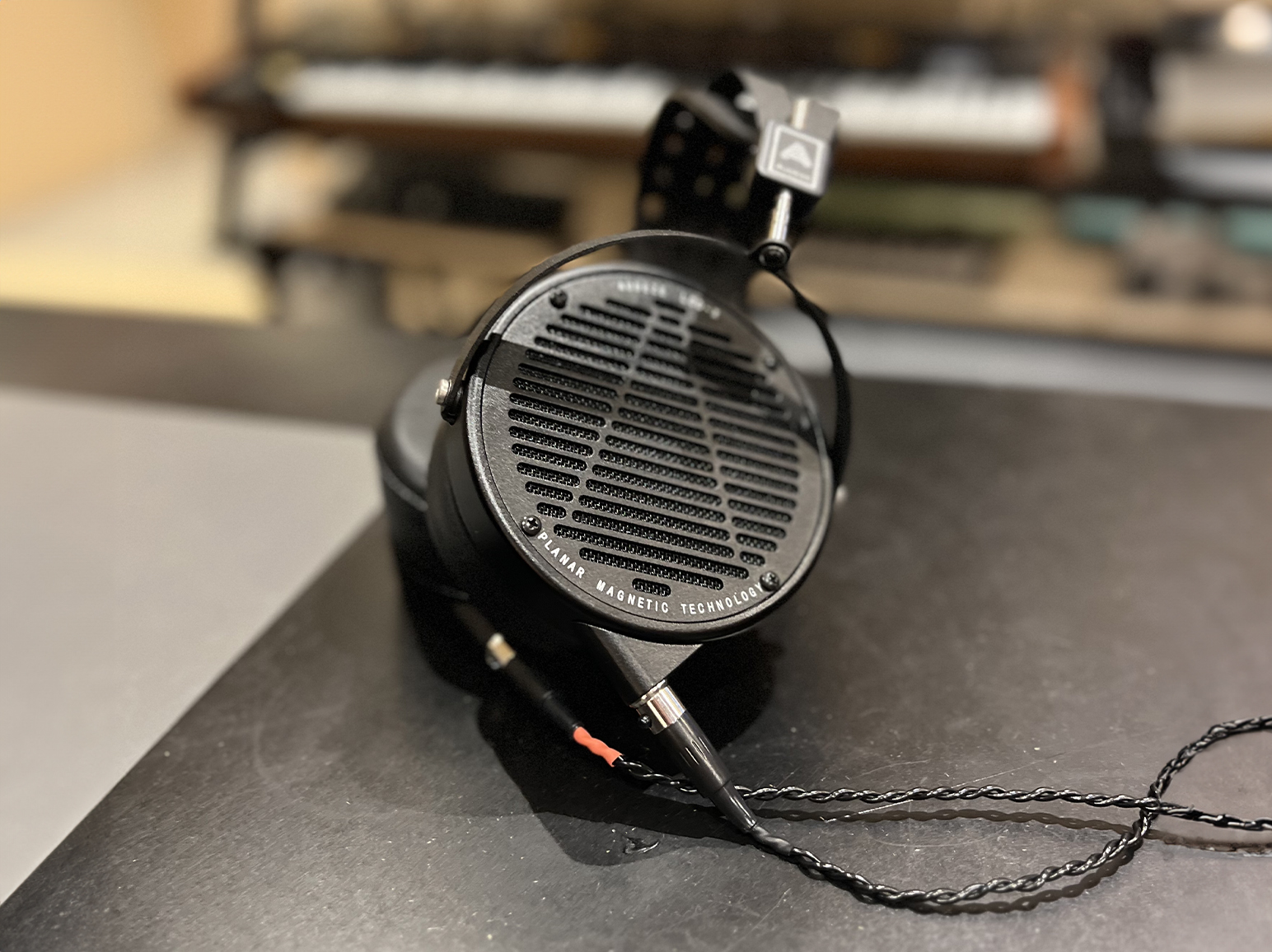
- Do you have any dreams to expand to other ranges of products; monitors, microphones etc that you can talk about?
Our engineering team occupies the entire upper floor of our building, and we spend millions of dollars developing new products every year, so there’s always something in the works! Being able to talk about new stuff is a different story, but they’ve definitely been exploring microphone technology for several years, and Dr. C has his own speaker company called Dragonfire Acoustics. We have some new gaming stuff in the works, and they’re constantly looking for ways to improve, so some sort of new flagship is inevitable (but hold your horses, nothing is coming soon haha!).
- And finally, what are your top 3 albums of all time?
Oh man, I can only pick three? In no particular order, three albums that always make me cry, and subject to change as soon as I hit send:
- Miles Davis “In a Silent Way”
- Kate Bush “Hounds of Love” (not related to Stranger Things, I’ve been loving this record since 1989)
- Fleet Foxes “Helplessness Blues”
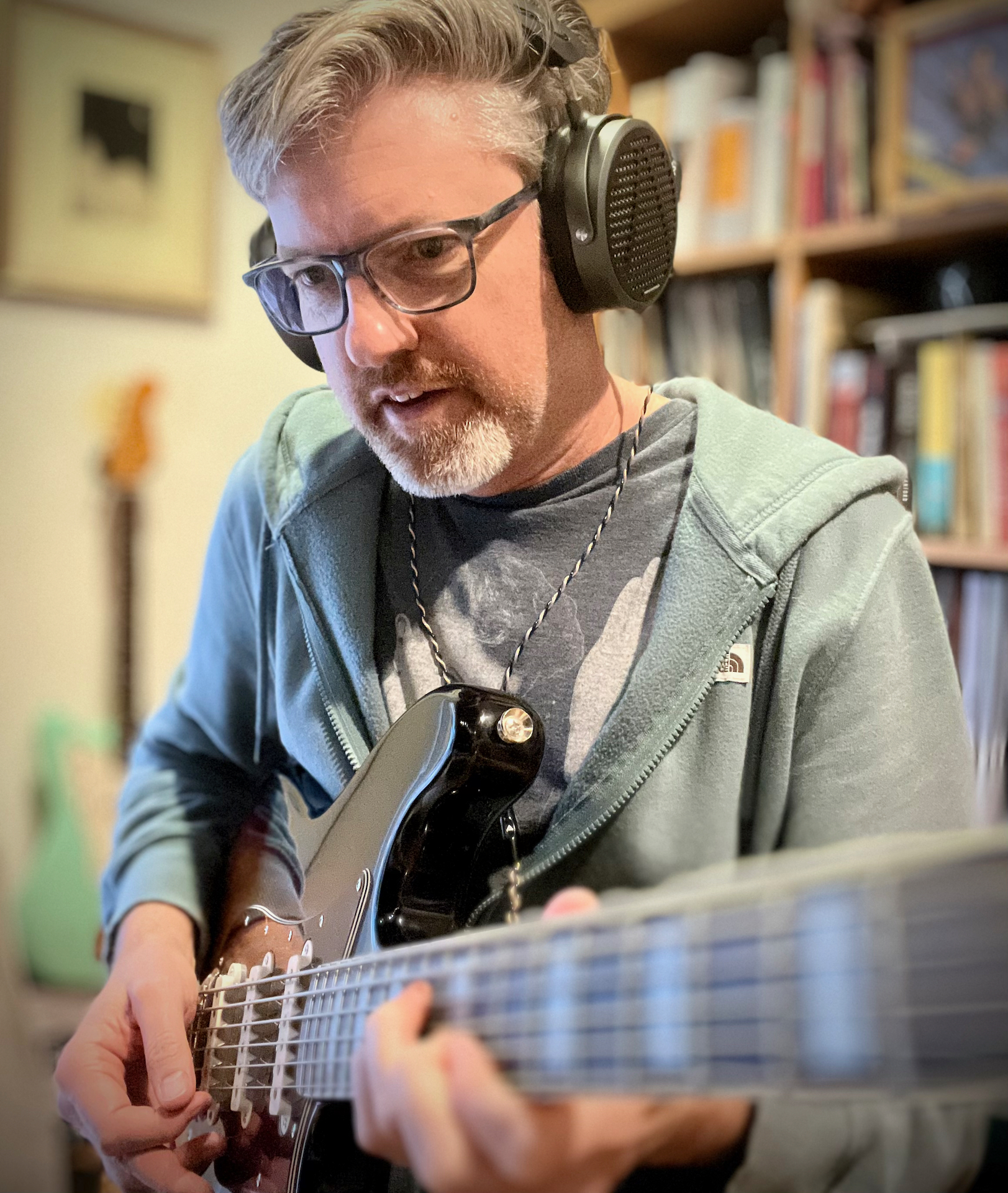
A big thank you to Chris for taking the time to speak to us on behalf of Audeze. It was a pleasure learning about his journey in the audio gear industry and gaining insights into the founding of Audeze. We are thrilled to be in partnership with such an esteemed and forward-thinking company. The addition of their exceptional headphones to our monitoring options elevates our capabilities and promises enhanced audio experiences for our members and clients!
At Ten87 Studios we offer long term studio hire and day hire music studios. Each recording studio is acoustically treated and sound proofed to optimise any type of audio recording and music production. We are home to a large community of musicians, producers, engineers and audio professionals working in the music industry. Our main day hire studio is a world class tracking facility equipped with the best in recording studio gear, instruments, outboard and backline. We’re based in Seven Sisters, Tottenham with easy transport links to the city centre – ideal for anyone looking for a London recording studio.
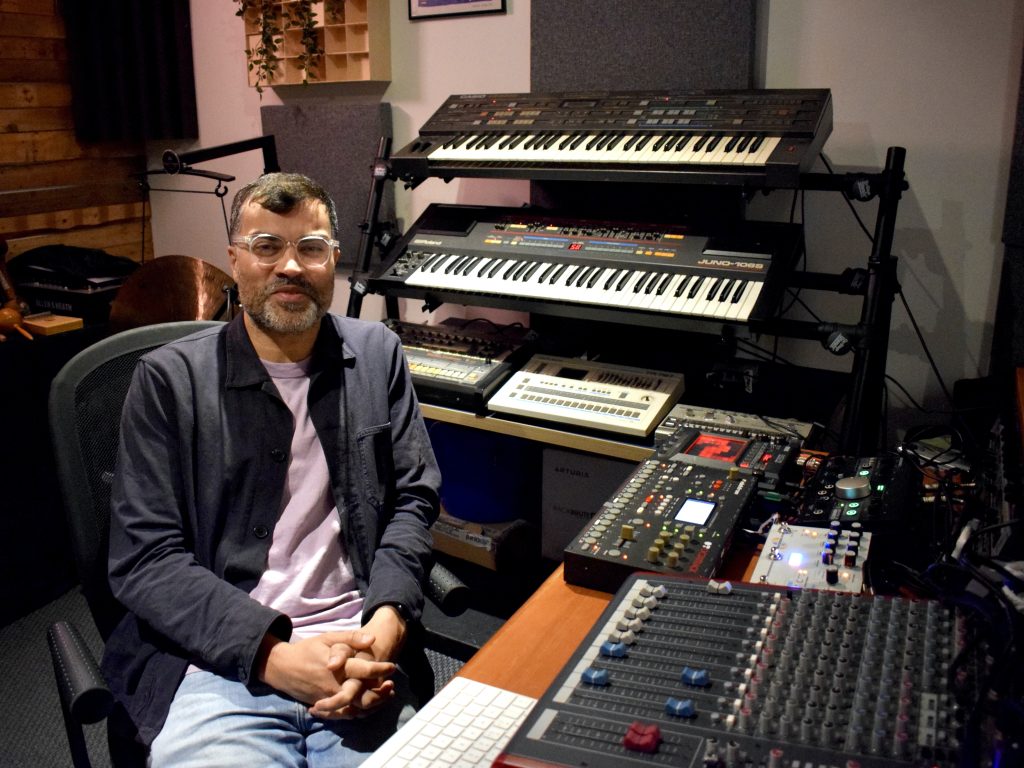
Auntie Flo
Brian d’Souza, better known as Auntie Flo, is an award-winning sound artist, DJ, music producer and live performer, known for ‘taking World Music into the future’ (The Guardian).
The multi talented musician is the central figure in the new breed of club music, fusing electronic and world influences alongside the likes of Four Tet, Daphni (Caribou), and Romare. As a DJ and live performer, Auntie Flo has toured extensively around the globe, performing in Asia, Australia/New Zealand, US/Canada, Africa, Latin America and frequently in Europe and the UK.
Auntie Flo has been described as offering a gateway to musical gems and strands of music that are lesser known and in need of exploration, and we had the great pleasure of catching up with him here in his Ten87 studio.We talked all things ‘Swell’, his new platform focusing on sound therapy, his vast collection of world instruments and the producer’s interesting techniques within his recording process.
Congratulations on the launch of your new organisation ‘Swell’! could you give a brief description of what Swell is? And about the positive links between music and wellness?
Thanks! Firstly, I shudder at the term ‘Wellness’ – it sounds so banal and fluffy. I guess what we are trying to do is reframe the conversation about what music and sound can be: the fact it isn’t merely ‘entertainment’ and that by framing it as such, really detracts away from the positive benefits we all get from listening to music and being immersed in sound. There is a great opportunity here: we are all expert listeners, and have been musically active as listeners since before we were born in our mothers’ womb. As a result, our ears are finely tuned to be able to listen to a wide variety of complex sounds at the same time, which in turn trigger a whole range of responses in our brain and nervous system, as well as our body. This then leads to a really fascinating field of study that is at the core of what we are doing with Swell – the way music and sound can unlock different states of consciousness and help one dive deeper into themselves and be more mindful of the world around them.
Did your interest in sound therapy spark from being a music producer?
I studied psychology and sound design at university and really focussed on how music affects our brain and body. As a DJ and producer, I get to continually see first-hand the effects that music has on an audience and the thing I love most about DJing is the challenge to get a room of strangers into a heightened state by playing songs in a certain order.
Training in Sound Therapy was the next logical step in my mission to understand how sound works from a behavioural and neurological level. I see Sound Therapy as a kind of inverse DJ set – instead of driving a euphoric state via the release of dopamine, endorphins and adrenaline, a sound therapy session entrains the listener to a deep state of relaxation, reducing heart rate and cortisol, the stress hormone. This then drives a lower brain wave state from beta to alpha/theta, which are commonly regarded as a place where we can be more creative and find better mental clarity.
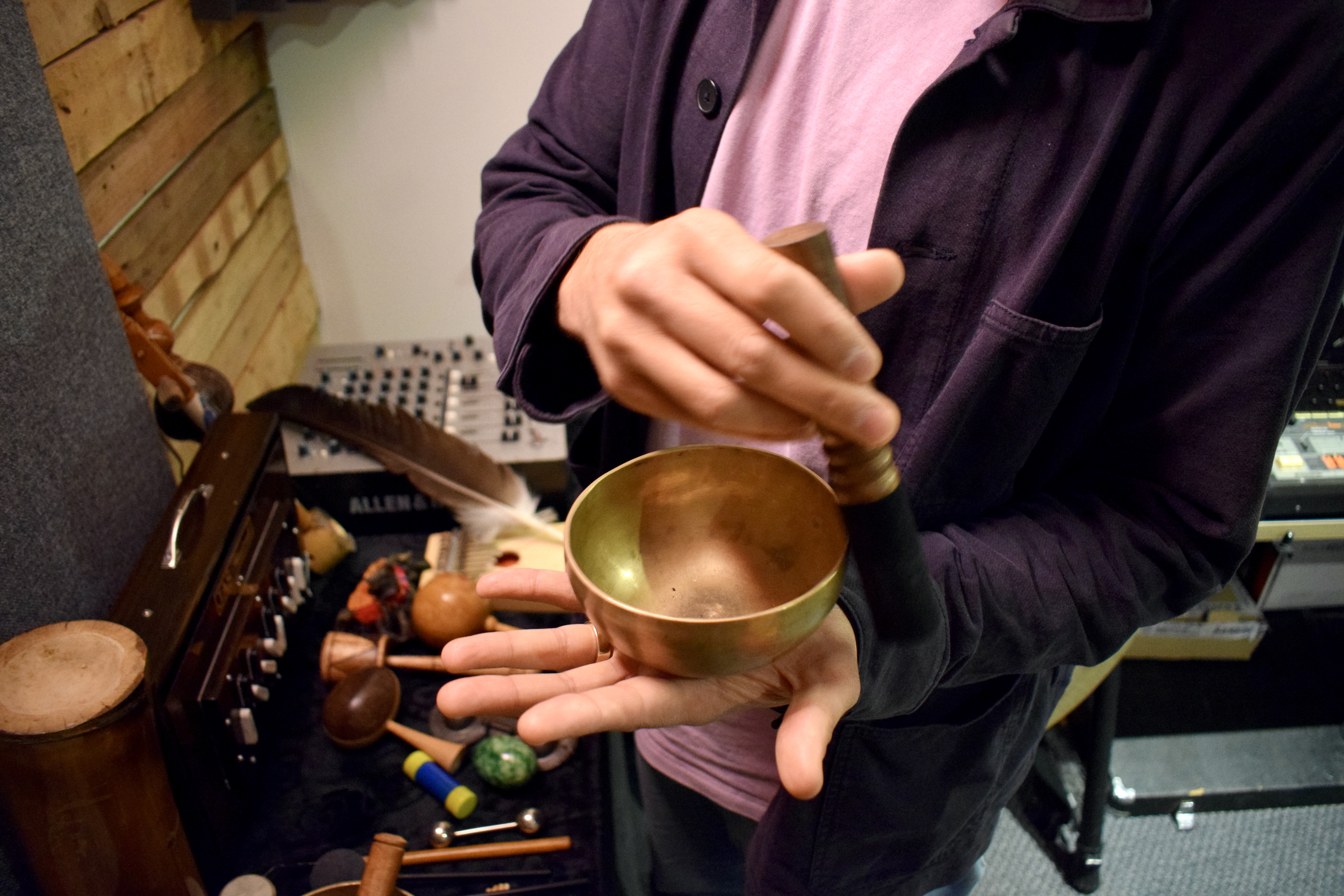
Could you tell us a bit about your collection of acoustic world instruments and the stories behind them?
I’ve always collected a lot of acoustic instruments, especially on my travels as a DJ. They all tell a story that is personal to me, but give me the chance to sample them and build a unique bank of sounds that is different to anyone else. This in turn gives me a better chance of making songs that sound unique. Over lockdown, I wasn’t able to travel so went on an eBay mission to buy lots of instruments – I picked up a Shruti Box from India, which has formed a crucial part of the new release I have with Sarathy Korwar. I bought a Soviet Era accordion to use as part of my Beacon. Black radio album that I was commissioned to by The National Trust, based on Orford Ness aka ‘The Island of Secrets’ in Suffolk, which was central to spying on the Soviets during the Cold War. I also acquired as many ‘sound healing’ instruments as I could, from condor feathers to a huge Sun Gong, which were all used as part of my Sound Therapy course.
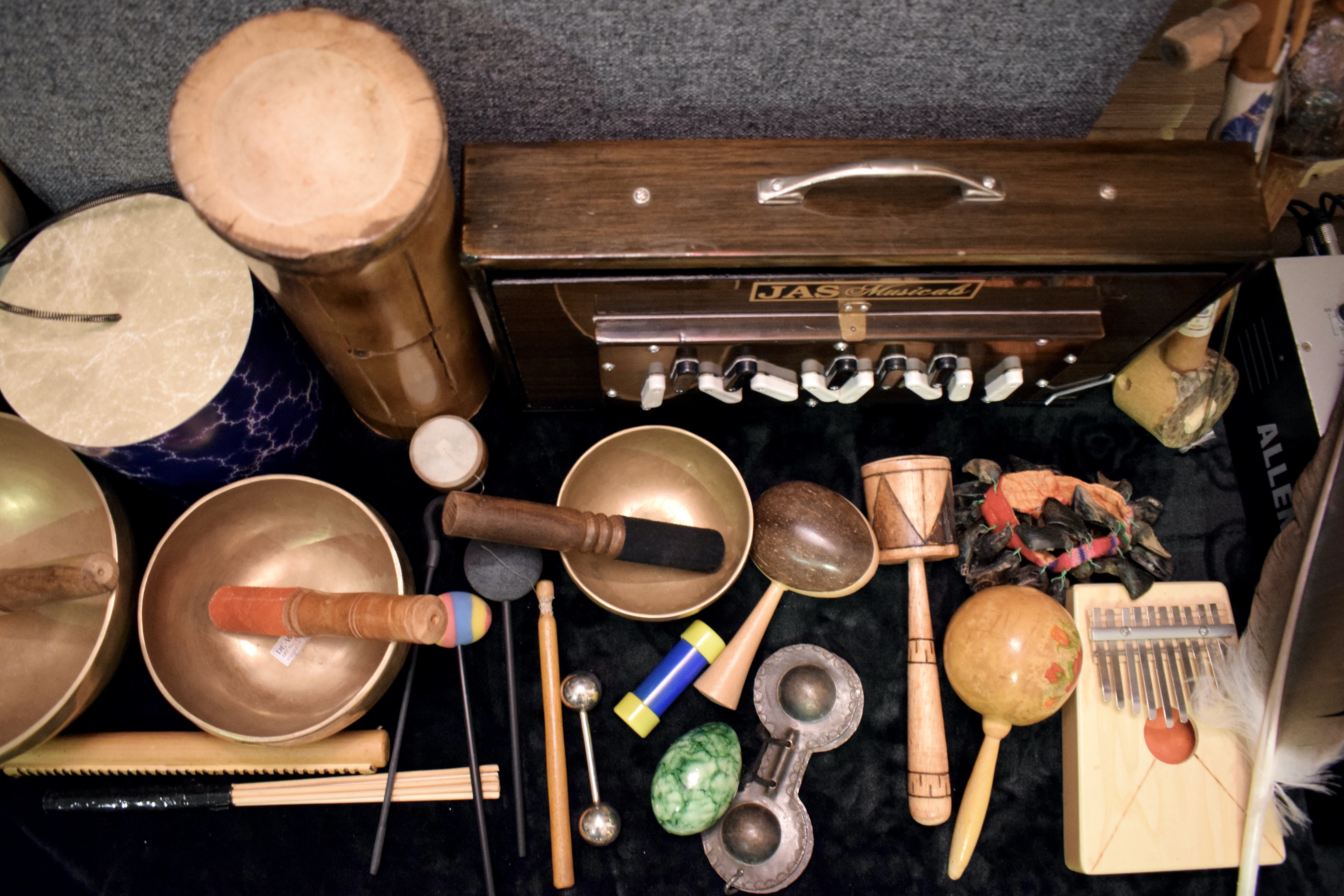
How else do you create original sound? Do you use outside field recordings in your music?
I’ve always used a lot of field recordings, but during lockdown I decided to train properly and did a 5-day course with the BBC’s world renowned sound recordist Chris Watson. I learned about lots of different mic techniques and ended up spending a lot on a bunch of high-end equipment, from shotgun mics to contact mics. This has helped take my field recording practice to another level – there is this whole sonic world out there that we don’t realise is there, masked underneath all the noise!
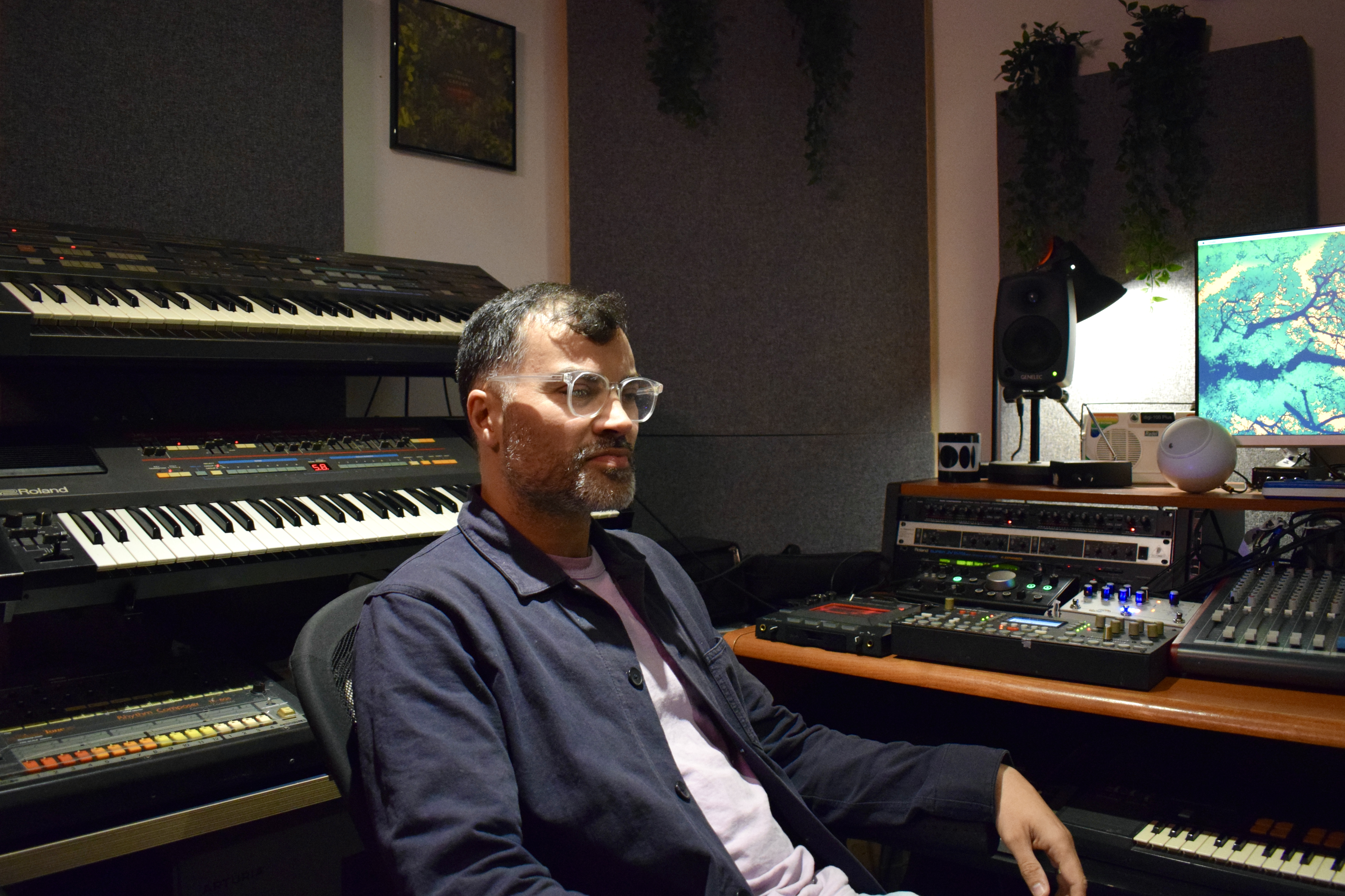
Can you tell us about the layout of your studio here at Ten87?
It’s pretty packed with a range of gear! I really like old Casios, and I must have around 10 of them. My favourite is the CZ5000, which is just so simple and pure. The crown jewel is my Yamaha CS-60, which was a bit of a spur of the moment eBay buy but once that I don’t regret – it is an incredible synth. I’ve also got a range of original Roland drum machines – 808, 727, 606 etc – still the best! I run everything through a bunch of effects buses to bring more character, so I’ve got a Roland Space Echo 201, which is a classic, as well as my new favourite the Hologram Microcosm. I try to do as much stuff out of the box as possible, and then record into Logic.
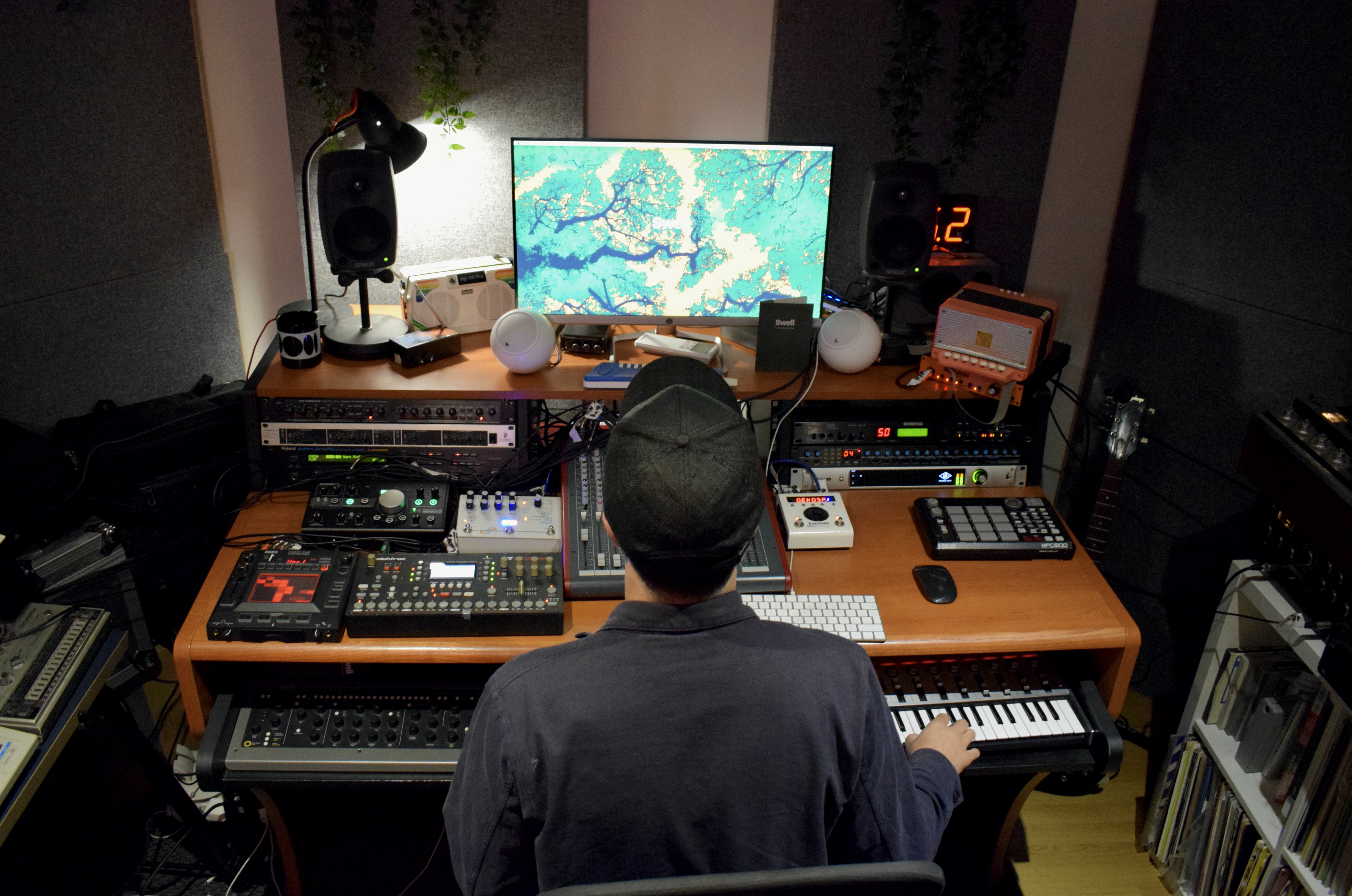
Big thanks again to Auntie Flo for chatting with us, and giving us an insight into his process. If you’re not already familiar with his work and music, go check out his Website and socials on Instagram, Twitter and Facebook and give Swell a download. We really look forward to seeing the new journey of ‘Swell’ and catching up again soon!
At Ten87 Studios we offer long term studio hire and day hire music studios. Each recording studio is acoustically treated and sound proofed to optimise any type of audio recording and music production. We are home to a large community of musicians, producers, engineers and audio professionals working in the music industry. Our main day hire studio is a world class tracking facility equipped with the best in recording studio gear, instruments, outboard and backline. We’re based in Seven Sisters, Tottenham with easy transport links to the city centre – ideal for anyone looking for a London recording studio.
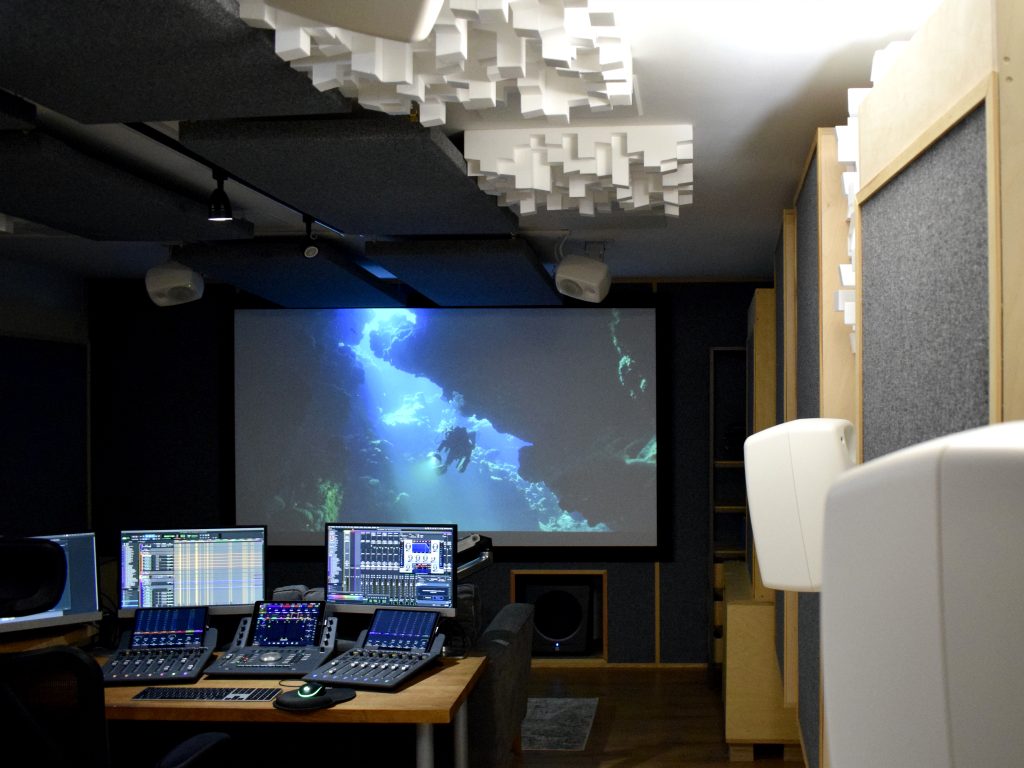
SoundNode
Introducing SoundNode, a company providing a full range of sound services for film, broadcast, multimedia and other audio-visual programs. They have worked behind the scenes on countless amazing projects such as for The Sir David Attenborough Green Planet AR Experience, music videos by artists such as Rita Ora and Childish Gambino, as well as clients including Adidas, and Gucci.
SoundNode integrates all the various stages of capturing and editing audio all within one team, under one roof. Providing any combination or the entire range of sound services necessary to make your production sound amazing. “I’m a big fan of SoundNode. Since discovering them 5 years ago, I’ve used them for location sound recording and audio post across multiple projects. Their audio skills are second to none.” Becci Ride, Producer/Production Manager – Disney, Formidable Media.
Exciting developments have been underway in their Ten87 Markfield Road studio, where a brand new Dolby Atmos set up has been installed. We were lucky enough to go down and have a peak during the installation process, and to see the final install. We spoke to SoundNode about some of their work and this fantastic new technology they have acquired.
Can you tell us a bit about SoundNode and the work you do?
In SoundNode we are a company made of a friendly and professional team of sound engineers who specialise in providing the full range of sound services for audio-visual productions. We pride ourselves in providing services of excellent quality and doing so with a friendly and creative approach, no BS, just loving what we do.
We offer both the on-set sound recording as well as the entire range of audio post-production services up to final mix and deliverables. In doing both we can make sure that the entire sound of a production can be taken care of under one roof, thus being able to maintain the best quality and creative direction throughout the entire process.
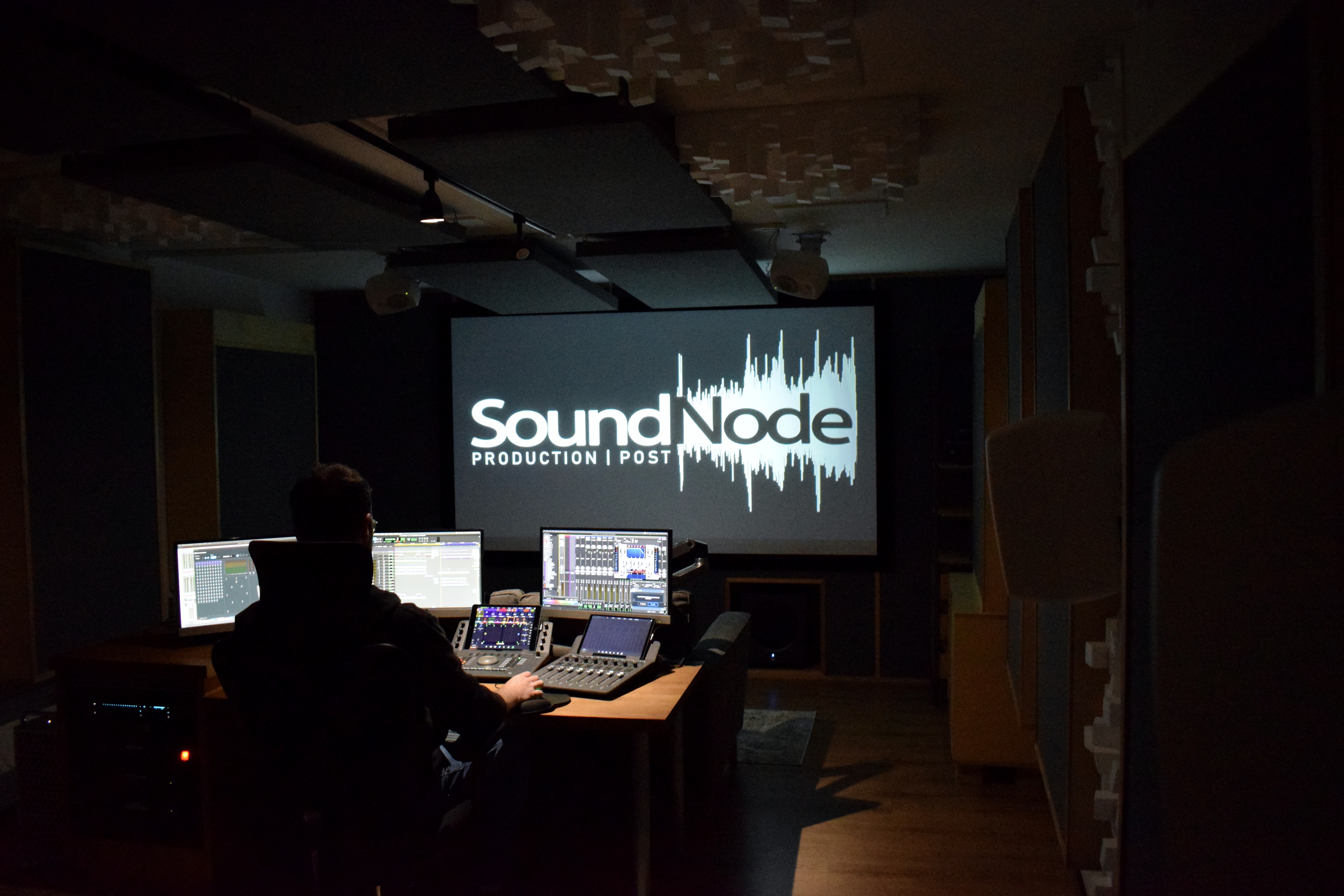
What are some of the favourite projects you’ve worked on?
This is a tough one as many jobs have been really exciting in very different ways. The content we work on is hugely varied and it ranges from Online Short Commercial/Corporate content to long form factual content, Theatrical Feature Films and TV/Streaming Series. So really the full roster of programs, all with their own thrills and challenges.
The projects we usually enjoy most are longer ones where we truly can bring the SoundNode experience of taking care of all things sound from beginning to end, being involved during the conception phase, to the shoot, and all the way until bouncing out the final mix. The vast majority of our work is part of a bigger collective effort with many departments who all add their contribution to the project and we thrive a lot in this collaborative environment. So our favourite projects are the ones where this collaboration is truly even, fruitful and creative. Often we have long established friendly and personal relationships with the people we work with and for – thus we might also favour projects where it feels like you are working with a bunch of old friends.
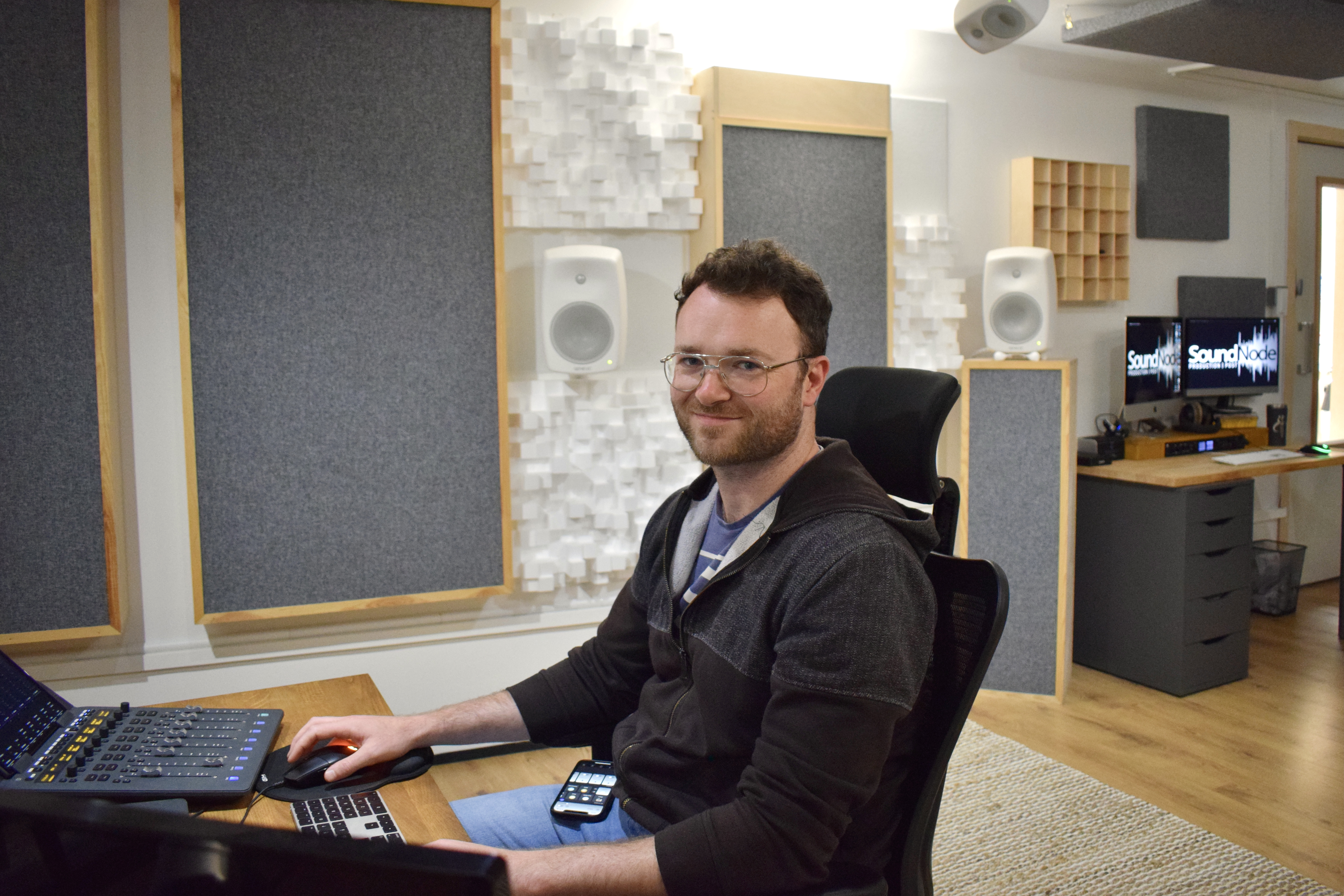
How has the installation of the Dolby Atmos system into your studio here at Ten87 been?
Atmos is still a quite new technology and as with every new technology there are some challenges in the install and setup. We already had a 7.1 setup before and the step up to 7.1.4 might seem small but due to various implications on the technical side and the workflows we did end up replacing the entire surround speakers system, our controllers, main monitoring controller, speaker calibration and main audio interface. But coming from 7.1, at least the general layout of the room and the majority of wiring and installation was there.
For this installation we have opted for a 7.1.4 system based around the Avid MTRX Studio interface which allow us to have a fully calibrated and time-aligned system through the DADman software, Focal Trio6 Be 3-way speakers for the front channels for excellent clarity and definition, full range Genelec 8040’s for the horizontal surrounds, bass managed Genelec 8020’s for the ceiling channels, and a JBL sub.
We also had to adjust and improve the acoustics as we now have more point sources in the room triggering sound from the ceiling downwards which was not the case before. So we opted for a combination of additional skyline diffusors and broadband absorption to be able to control the reflections without making the room sound dead or dry. This coupled with our existing 110″ acoustically transparent projection screen really creates an exceptional listening environment.
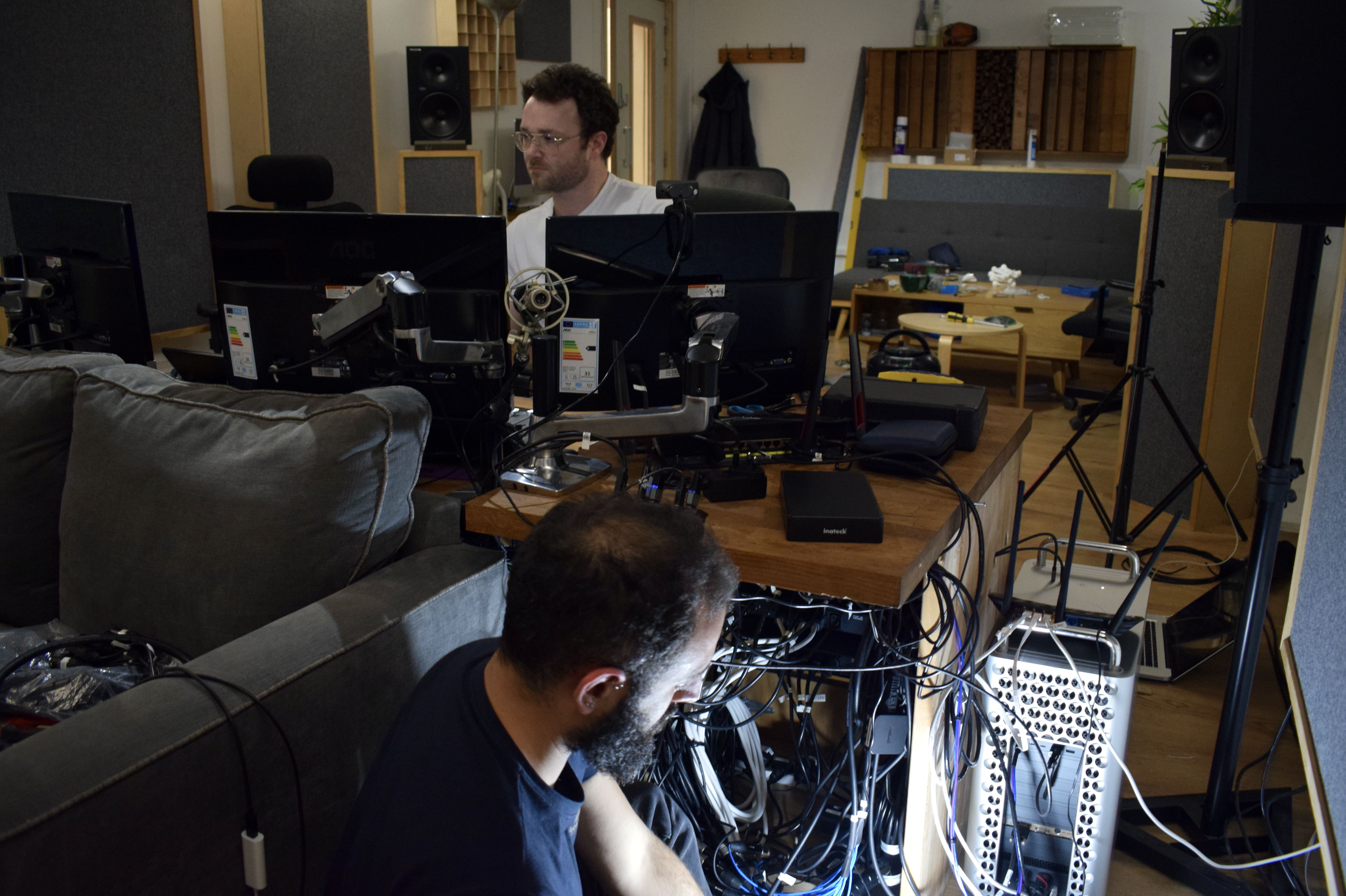
What are the main features of this new technology?
Basically since the 1930’s – when stereophonic sound and even rudimentary forms of surround sound were first being experimented with – we have been panning in the same way: the pots controlled how much level to send to one or the other speaker. This was the same for the digital surround sound formats such as 5.1 and 7.1, which became more popular in the 90s, but just with more speakers. The issue with this is that, as it was a fixed level to each speaker, if the speakers in different listening environments were placed in different positions to the original one, it would result in the intended panning of the source being affected. And we all know that every room and setup is different, thus we were left with either playing it fairly safe in terms of using the surround field or living with the fact that “bold” panning that might sound cool in the sweet spot of one listening room might be not working so well for a viewer sat in a different room.
Dolby Atmos revolutionises this, as it is not just a system of more speakers around and on top of you, but it also changes the way we can pan the ‘Objects’ within the space. In Dolby Atmos, we move ‘Objects’ to a position in space and it is the Renderer that then decodes what level it needs to send to each speaker for that ‘Object’ to be reproduced from that position based on the room and speaker setup that you have. The more speakers you have, the more accurately these positions can be reproduced, but the system allows you to go down to stereo and do a binaural render to make sounds come from all around you just while wearing headphones (with each system’s limitations that is).
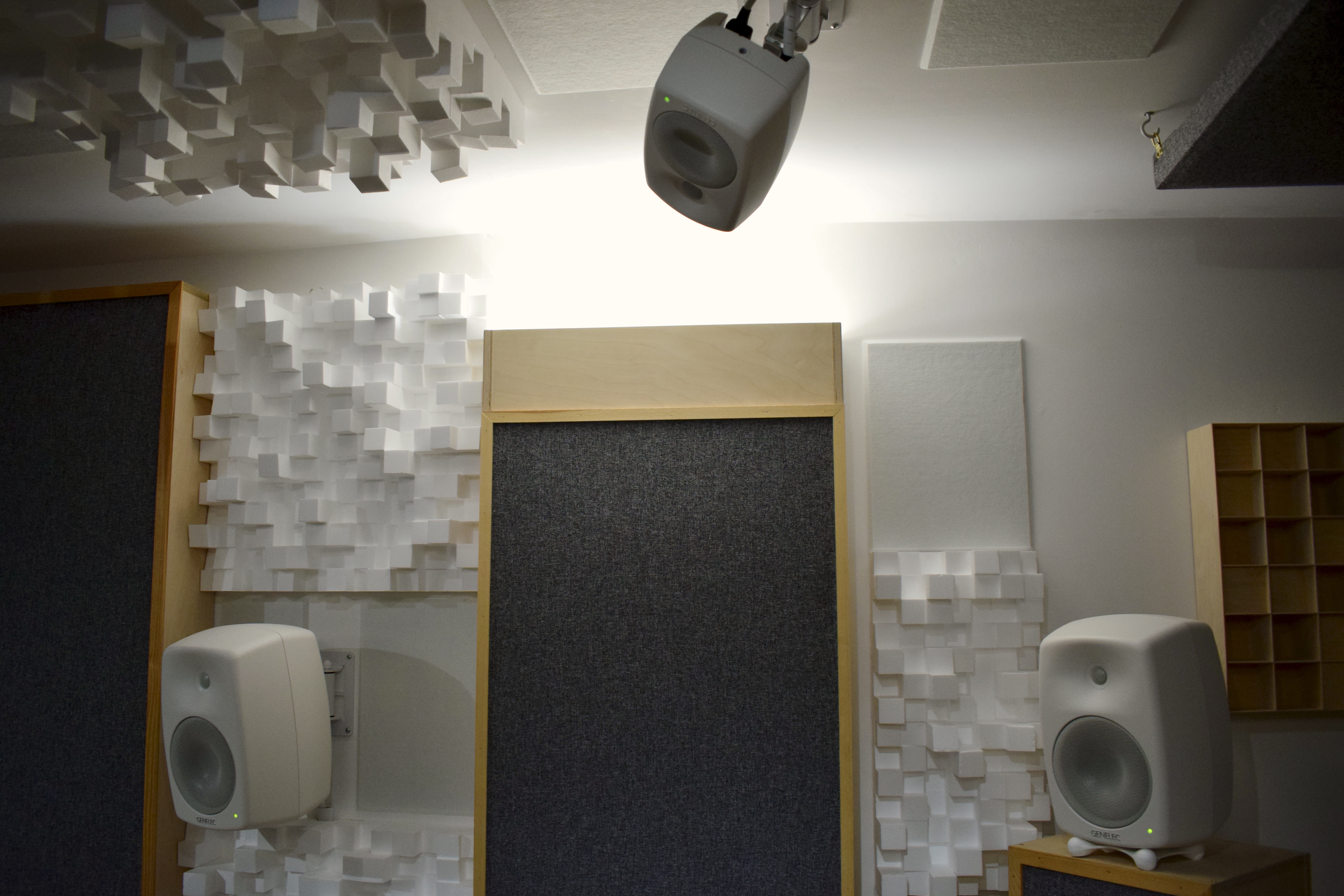
So what does all of this mean for the end users? Well first, Dolby Atmos now introduces height with ceiling speakers, so the full 3D space is a reality: planes flying over your head, birds chirping up in the trees, rain falling on top of the roof, etc. can all be achieved which was not possible before. Additionally and perhaps even more importantly, the same mix can be reproduced in multiple different systems, with different amounts of speakers and channels; in surround sound systems, home entertainment sound bars, as well as binaural renders on headphones, and everything in between. It also allows for better translation of the mix from the dubbing room to the listening room, as the system compensates for the differences of the rooms and speaker amount/placement.
What will having the Dolby Atmos system mean for SoundNode?
Dolby Atmos has now been around for a while, and it is clear that it is here to stay as we now see platforms like Netflix, Disney +, HBO Max, Apple Music, Tidal etc. all streaming content in this standard. Additionally, the Home Entertainment environment has become a very significant one for the industry and further becoming more so in the near future. We have set up our facility especially for these kinds of programs and environments, letting us and our clients produce top quality content in excellent monitoring facilities, particularly designed for their audience and their audiences’ expected listening environments.
For work on big Theatrical Dolby Atmos film mixes, the technology and our setup allows us to do all of the pre-mix work in our more competitive facilities and then easily translate that mix when taking it to the large format Dubbing Theatres for the final mix.
And finally from a creative point of view, we are now approaching the track-laying and sound designing differently and taking into account the 3rd dimension. We are thinking what comes from above, we are thinking vertically as well as width, depth, front and back. Basically, making programs more immersive and exciting for the audience with a very powerful tool to make great sounding and emotionally engaging content.
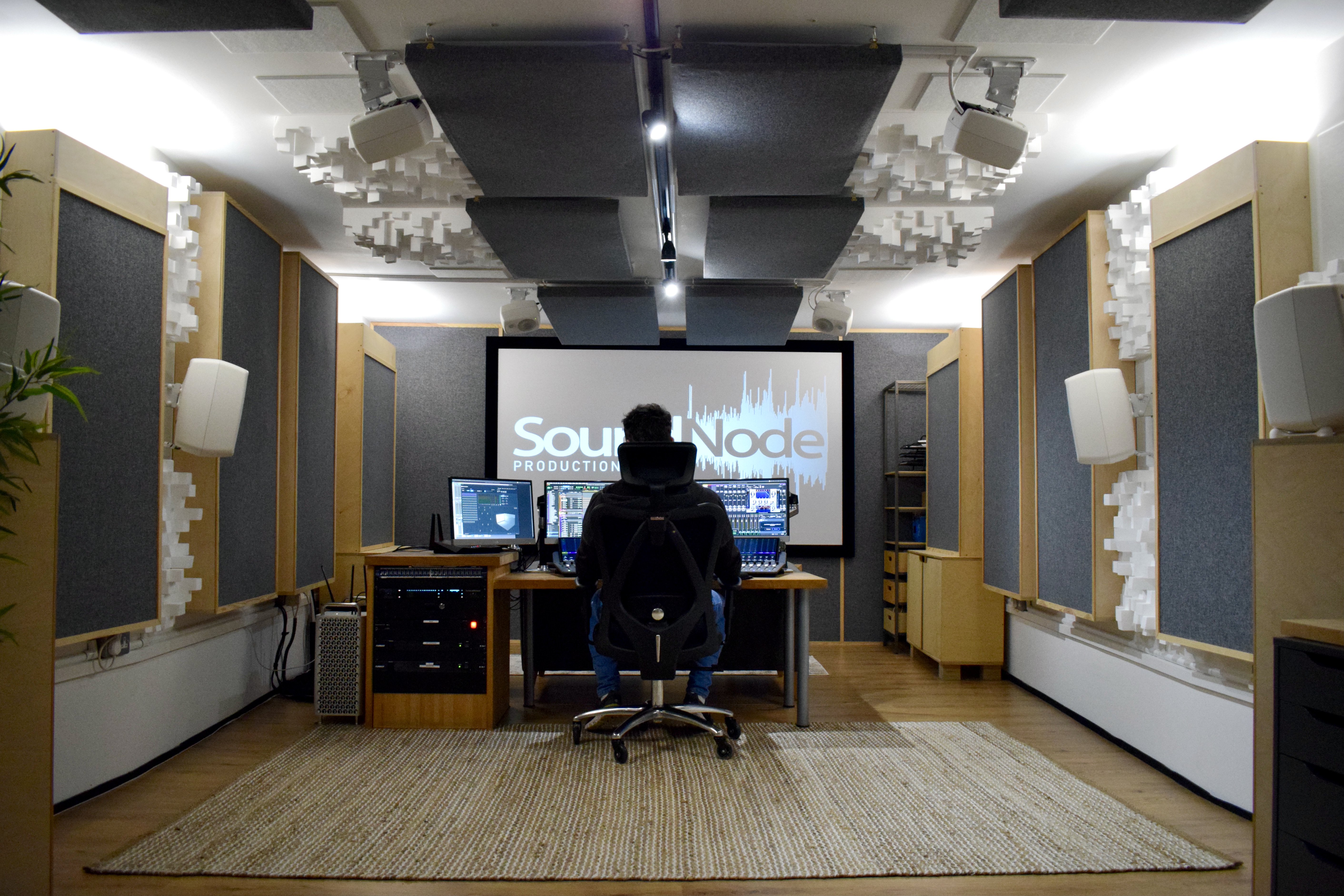
Thanks so much to SoundNode for sharing your world, and chatting with us about your exciting new set up! If you’d like to keep up to date and follow SoundNode’s journey then check out their socials on Instagram and Facebook, and also on the SoundNode Website.
At Ten87 Studios we offer long term studio hire and day hire music studios. Each recording studio is acoustically treated and sound proofed to optimise any type of audio recording and music production. We are home to a large community of musicians, producers, engineers and audio professionals working in the music industry. Our main day hire studio is a world class tracking facility equipped with the best in recording studio gear, instruments, outboard and backline. We’re based in Seven Sisters, Tottenham with easy transport links to the city centre – ideal for anyone looking for a London recording studio.
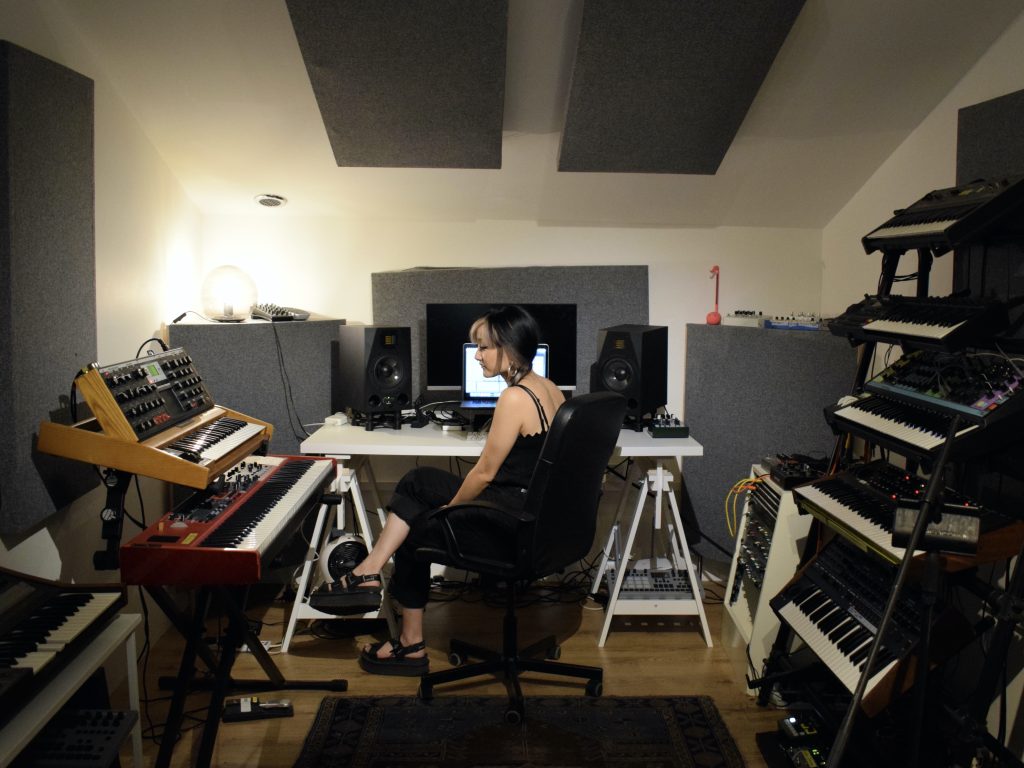
Hinako Omori
Hinako Omori is a wondrous producer and musician from Yokohama, Japan. Her thoughtfully crafted compositions weave between forest bathing, ambient electronics and celestial soundscapes, which transcend the experience of them into something more than music. We were lucky enough to be invited into her studio to take a brief peak into her musical world. The critically acclaimed artist talked to us about her release ‘a journey…’, and gave us a generous insight into her process, as well as some of the new technologies she is exploring such as binaural sound.
Can you tell us a bit about the themes and concepts behind your new project ‘a journey…’?
Of course! “a journey…” came into being through a very kind invitation from my friend Oli Jacobs, head engineer at the beautiful Real World Studios. It was during the Summer of 2020, and as we were still in the first wave of the pandemic they weren’t able to host WOMAD Festival in person as they would usually do. They arranged an online, immersive audio version, and Oli very kindly asked if I’d be interested in taking part. I’ve always been fascinated by binaural and immersive audio, so I was over the moon!
I had a couple of weeks or so to put something together, so I decided to piece together some demos to make a continuous piece and took the stems up to Real World. The day before the mixing session, the lovely Katie May (who is an incredible engineer also at Real World) and I took a binaural head to the surrounding areas of nature, such as the Mendip Hills, and the piecing together of the songs and field recordings became the album.
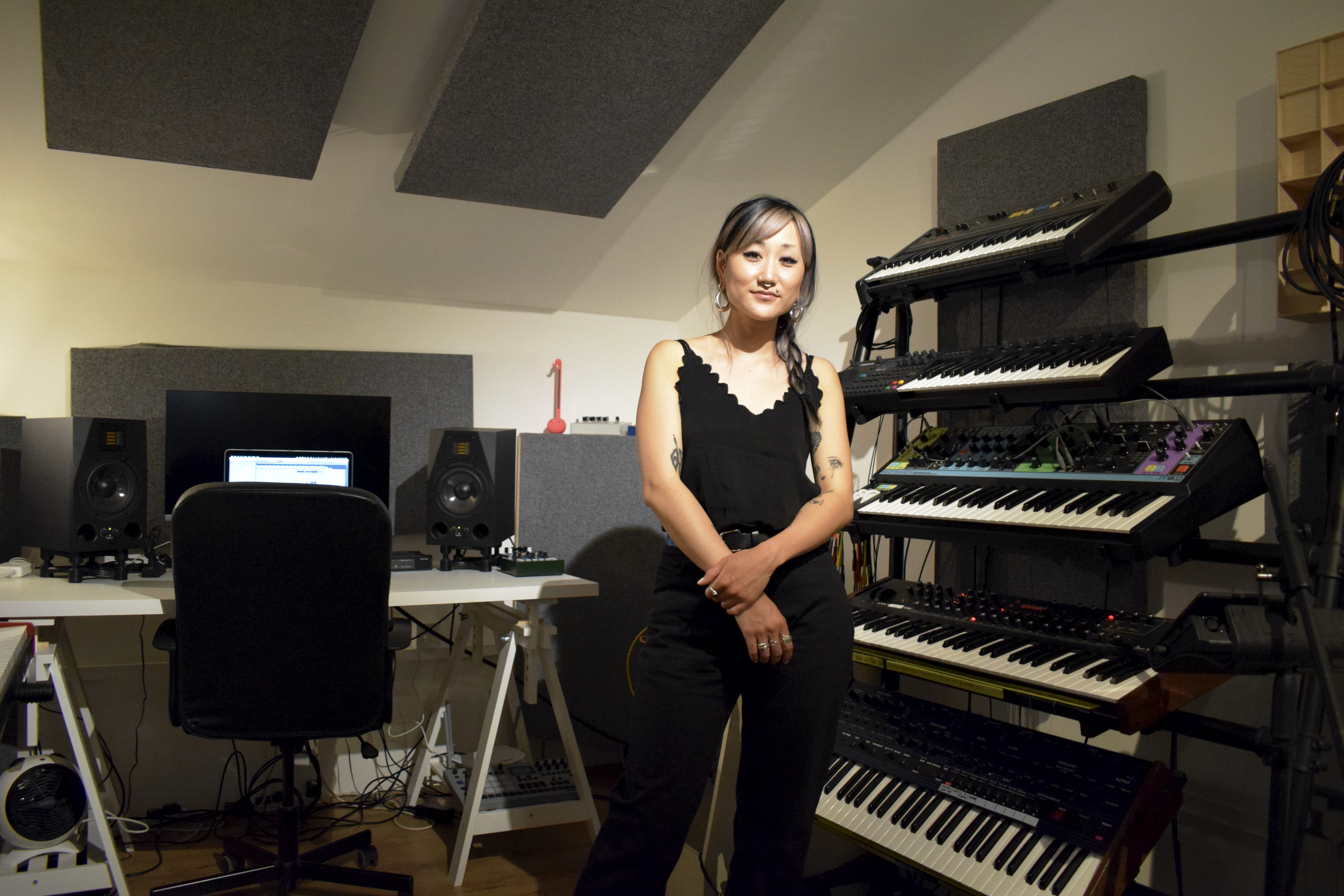
The use and importance of binaural sounds comes up in your work, could you tell us a bit about what this is and how it works? And why it is important for your music.
Binaural sound (very broadly!) is literally how we hear sound through our ears – how sound waves arrive at each of our ears at different times, enabling us to place the source of the sound and create a spatial awareness.
Binaural recordings can be used to create a more immersive atmosphere and experience, and one of the ways we can do this is by using a dummy head with two microphones placed where our ears would be, capturing the audio how we would hear it.
As this project was during the beginnings of the pandemic and I was conscious that not everyone might have access to nature, I wanted to create an atmosphere where you could pop on some headphones and fully immerse yourself in nature from the comfort of your own home – I feel that the binaural field recordings that we captured from the forests around Real World Studios definitely helped me in creating a sonic environment for the music.
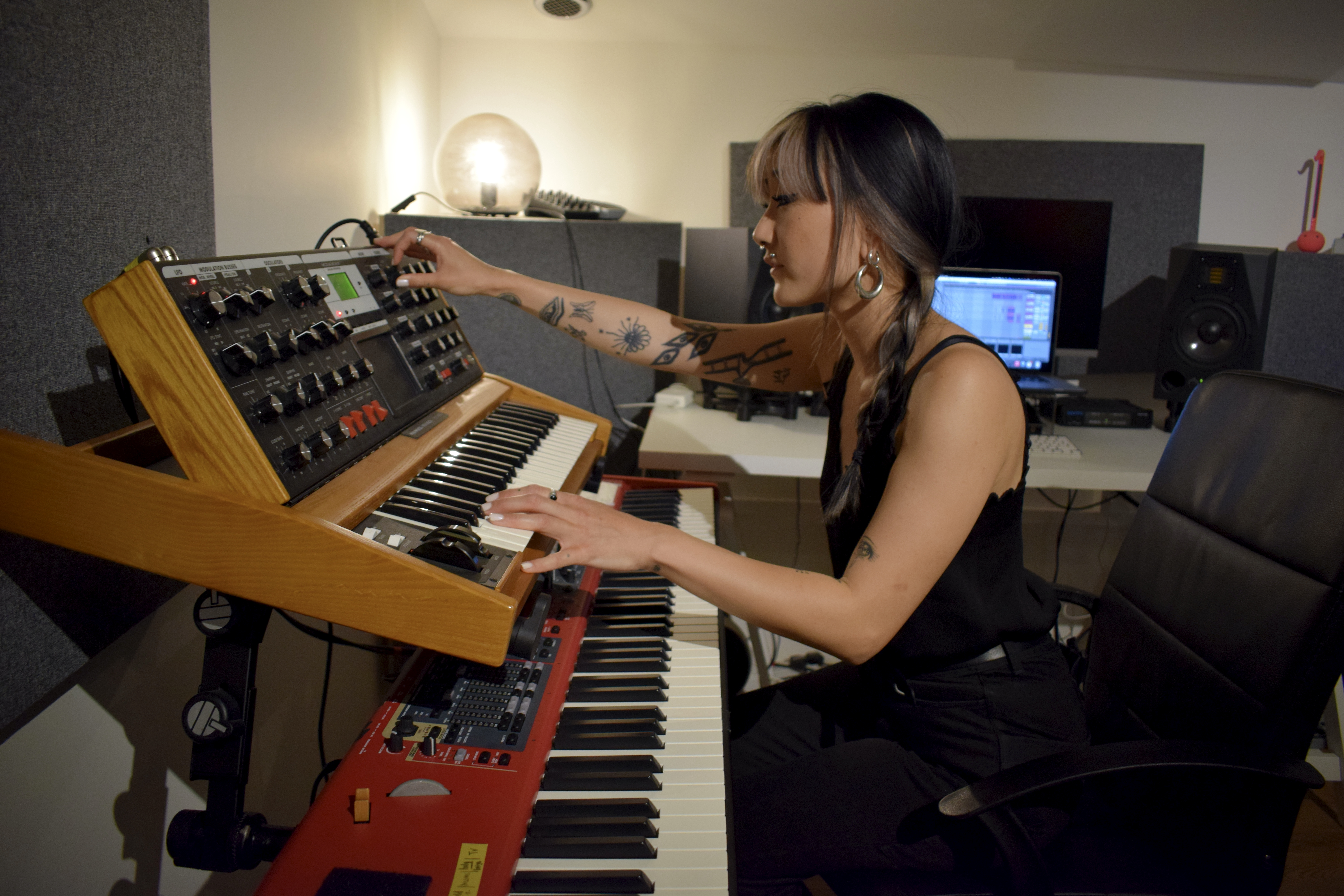
Have there been any essential studio tools/items that have helped you through the process of making your new album?
My dear synths, Sequential Prophet 08, OB6 and Moog Matriarch – I love them and use them on everything!
How would you explain the relation in your work between sound and visuals?
It’s a really interesting question as I’m not sure necessarily if the visual side of things come into my head at the start of the music creating process for me, unless it’s for a particular project or theme. I think a lot of the time it becomes clearer as the project unfolds, perhaps!
I’ve been incredibly lucky to collaborate with artists I admire greatly on visuals for different projects – Gustavo Eandi and Emi Takahashi on release artworks, and Thomas Harrington Rawle and Jessie Rodger on visuals for live shows/videos. Emi also created videos for “a journey…”. It’s been such an absolute honour to collaborate with them, and to see their magical vision come to life.
How has your experience been being a part of the Ten87 community?
It’s been such a lovely experience getting to know the incredible community here, and there’s always so many wonderful opportunities for collaboration. It really is a very uplifting environment with a very warm energy, and I’m really grateful to have met everyone here.
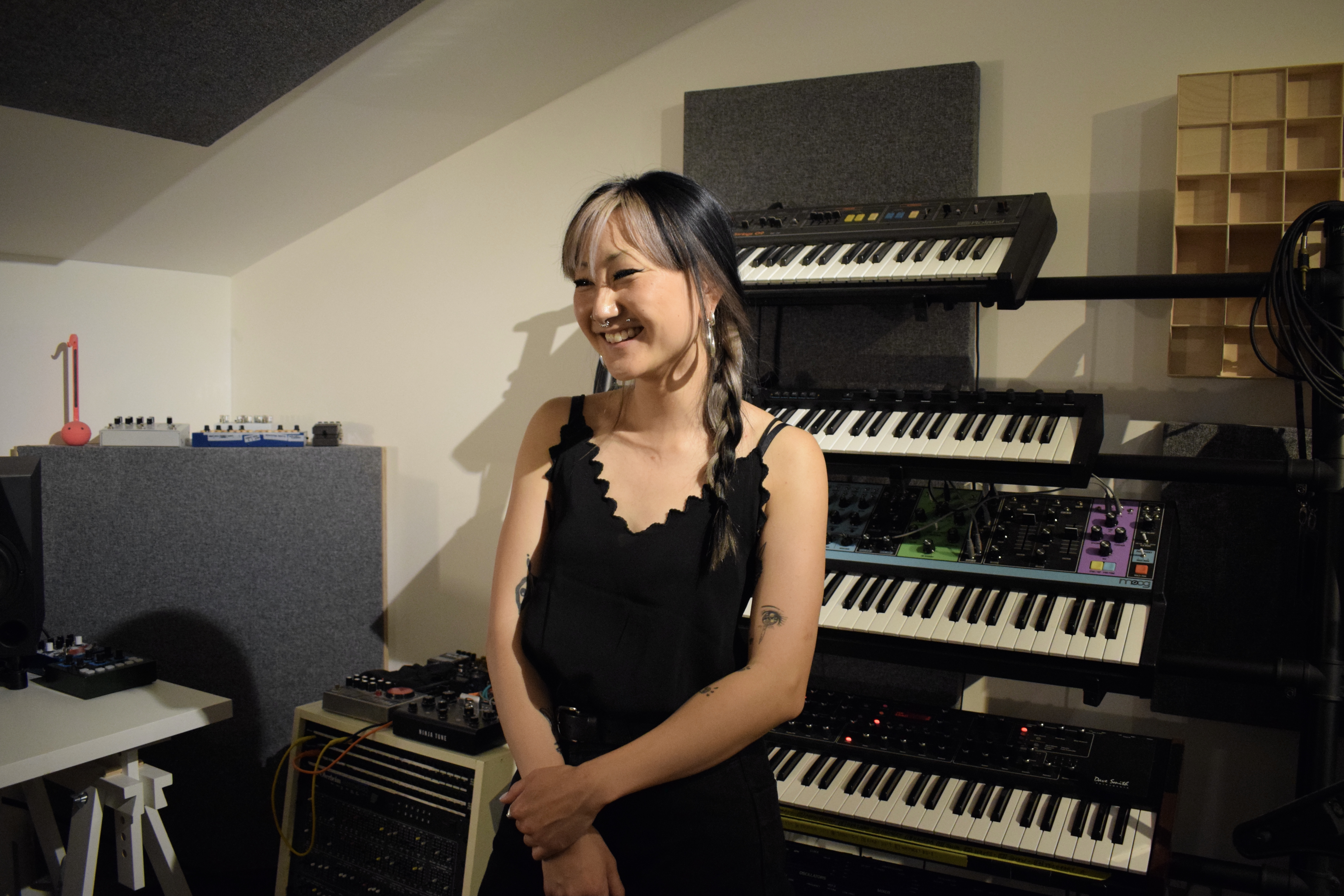
Thanks so much to Hinako for showing us around her Ten87 studio and sharing her world with us. If you haven’t already listened to ‘a journey…’ The project is available to stream on all platforms. She has also recently released a collection of reworks of the album called ‘a journey with friends…’.
We wish Hinako the very best for her upcoming tour of ‘a journey…’, being the first time to hear this project live. To keep up to date with her journey visit her website and Instagram.
At Ten87 Studios we offer long term studio hire and day hire music studios. Each recording studio is acoustically treated and sound proofed to optimise any type of audio recording and music production. We are home to a large community of musicians, producers, engineers and audio professionals working in the music industry. Our main day hire studio is a world class tracking facility equipped with the best in recording studio gear, instruments, outboard and backline. We’re based in Seven Sisters, Tottenham with easy transport links to the city centre – ideal for anyone looking for a London recording studio.
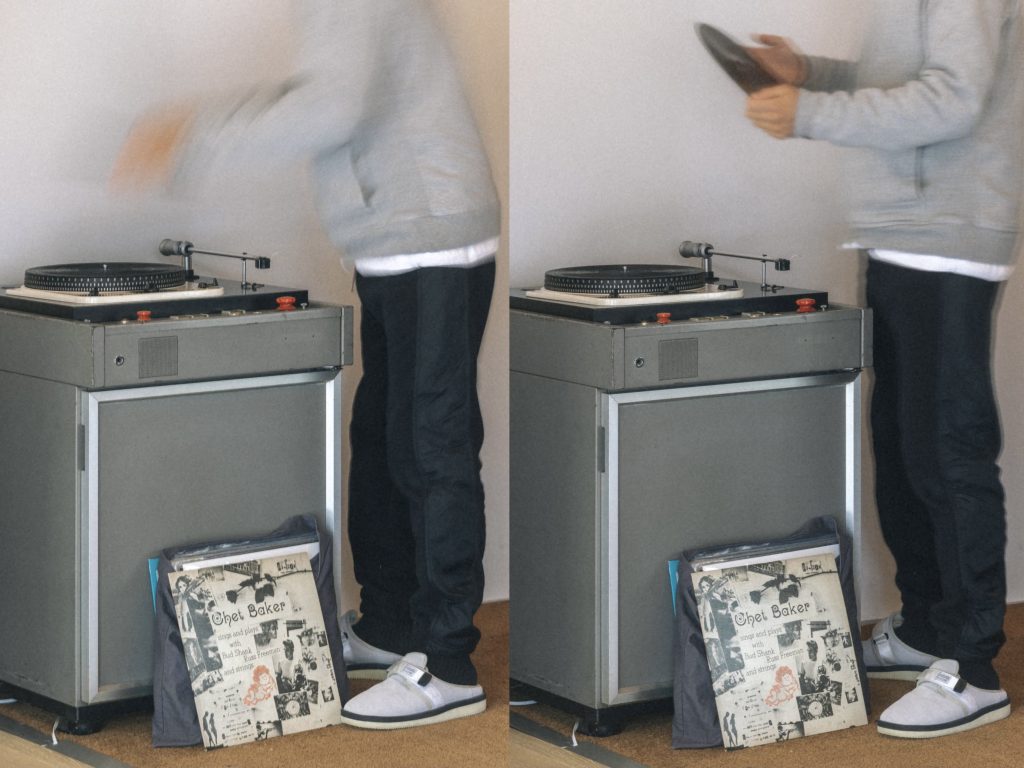
Taishi Fukuyama
Introducing Taishi Fukuyama, artist, producer and serial entrepreneur in the music/tech world. Taishi’s musical journey through many interesting projects led to him to co-found Qrates, an online platform based in Tokyo supporting independent artists to release physical vinyl copies of their music. Through the seamless online interface that Qrates provides, artist’s have full control over their release, but with the support from a team of music lovers.
How did your career in music first start?
I played in a bunch of bands while I was in high school and university, one of which became the first Red Bull Soundclash champion in Japan (now disbanded). My aspiration to become a full time recording artist unfortunately didn’t get me far enough, but I never had any other talent or interest outside of music, and ended up buying my first mac with the money I saved up waiting tables and started making beats and producing artists. I was very lucky to have been able to quickly get connected with some of the larger names in the Japanese major labels at the time. That was my early twenties.
As an artist / producer, what have been your favourite projects you’ve worked on?
I really cherish all of the records I’ve been able to work on; ranging from working in the most expensive studios in Tokyo with all of the outboard gear and vintage mics to geek out over for days and also working and recording with independent artists in my very small Tokyo apartment bedroom. One record that comes to mind is the song I co-wrote with the Korean artist BoA. She wrote the lyrics in Japanese, a message to her parents and I recall some of the candid conversations in the studio to this day.
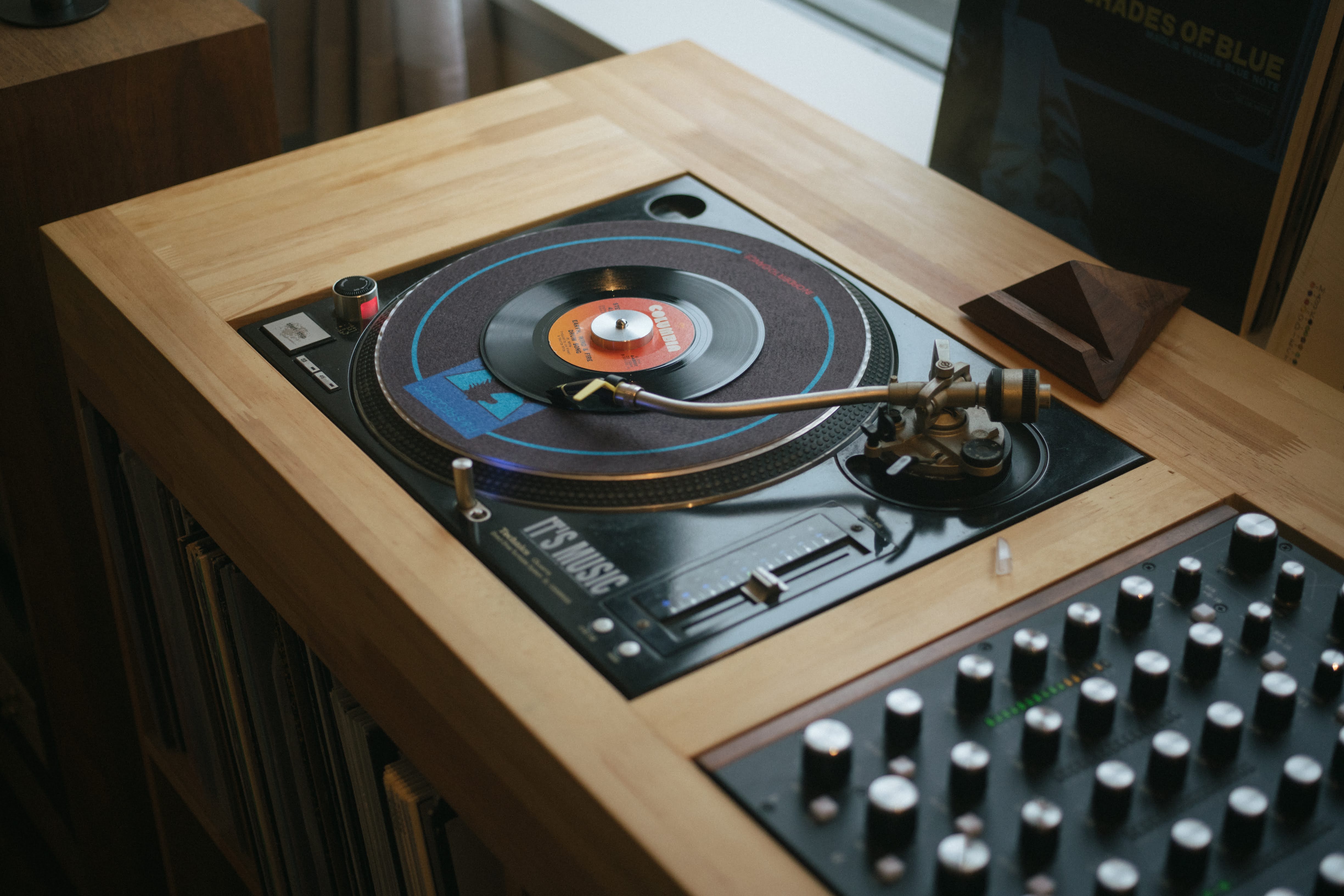
Through the various musical paths you’ve explored throughout your career, what brought you to creating your platform Qrates?
First of all, I certainly don’t take all the credit for starting Qrates. Throughout the start and ongoing journey, Qrates is a team like no other. But personally speaking, what keeps me going is seeing and feeling how music on vinyl can be the world for so many who genuinely love music. It’s like magic how music can consume and become your identity. There’s no doubt that physical sales are often less visible compared to digital, but there’s something about a vinyl record that can help get you to that magical place. It makes a huge difference both to artists and fans on many planes. I personally don’t really relate to the hardcore hi-fi audiophile world which vinyl is sometimes associated with; what music on physical means to someone can and should be different and I’m all for that.
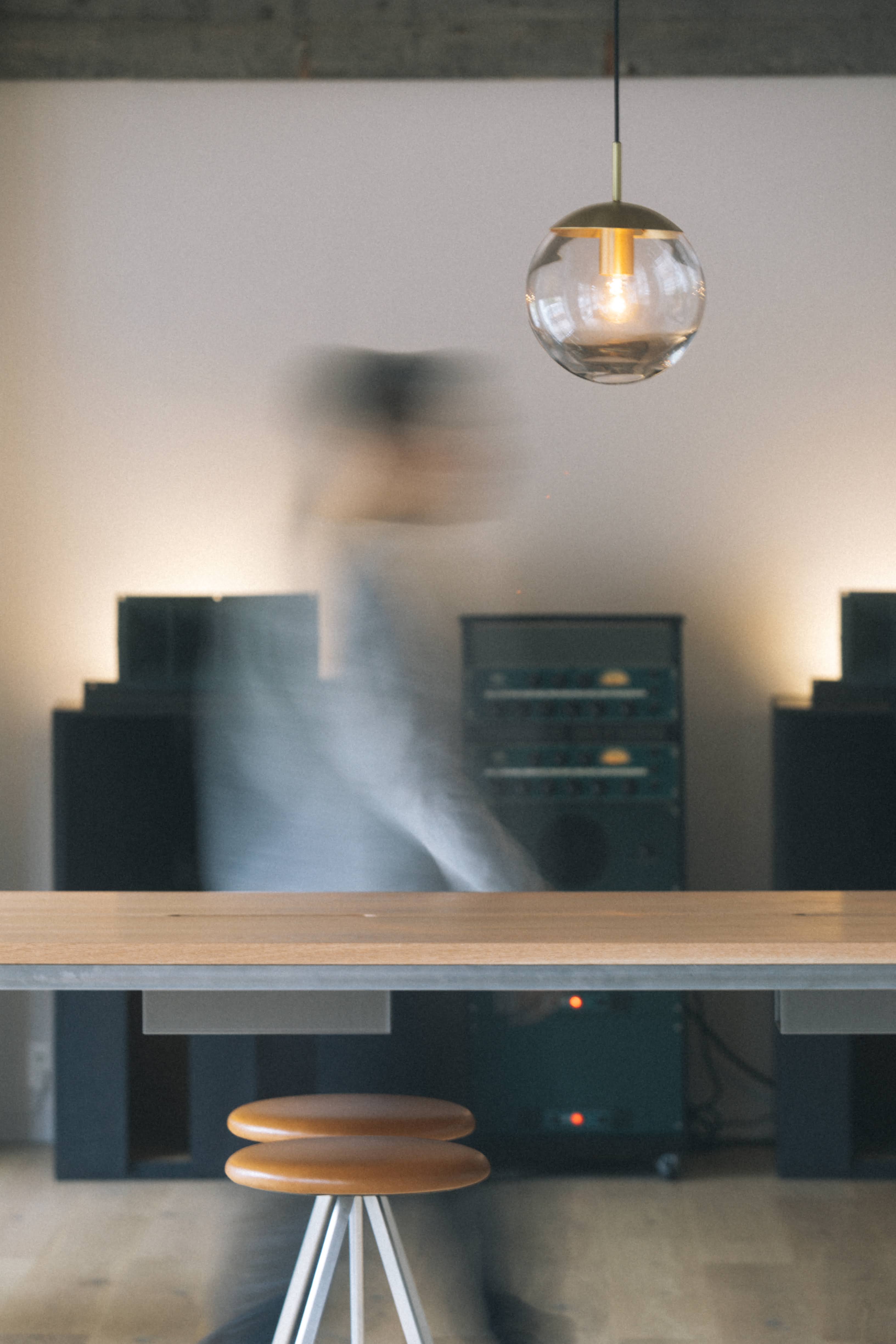
What are the benefits of artist’s releasing physical copies of their music with you over other distribution channels?
I would say 2 things. First, it’s truly a one-stop shop. From making the record, selling it, storing inventory, shipping globally, getting into retail stores, and all the artist and customer support along the way, we have an experienced team looking after your music. Second, we can also work with your distributor by supplying the records if you already have one. By selling direct-to-fan on Qrates in conjunction with selling wholesale through a distributor with Qrates, you get the benefits of economy of scale with your manufacturing.
What are the main differences you can see in how vinyl is distributed now compared to when you first started in the business?
Going further back in time, the general trend I believe was that there used to be a limited number of record titles released but they sold many. Think all of the big name reissues. Now, there are many more titles being made, but the quantity per title is fewer. We certainly contribute to this trend for sure. Since starting in 2015, every year, we have more and more artists using Qrates for vinyl and hopefully we’re looking less crazy for starting such service. In regards to some of the recent topics around big titles that “clog up” the global vinyl manufacturing capacities and independents being muscled out of access to vinyl manufacturing, I wish those independent artists and labels would come to Qrates to see what we can offer. Hopefully the physical world is not as dark and bleak as it may seem.
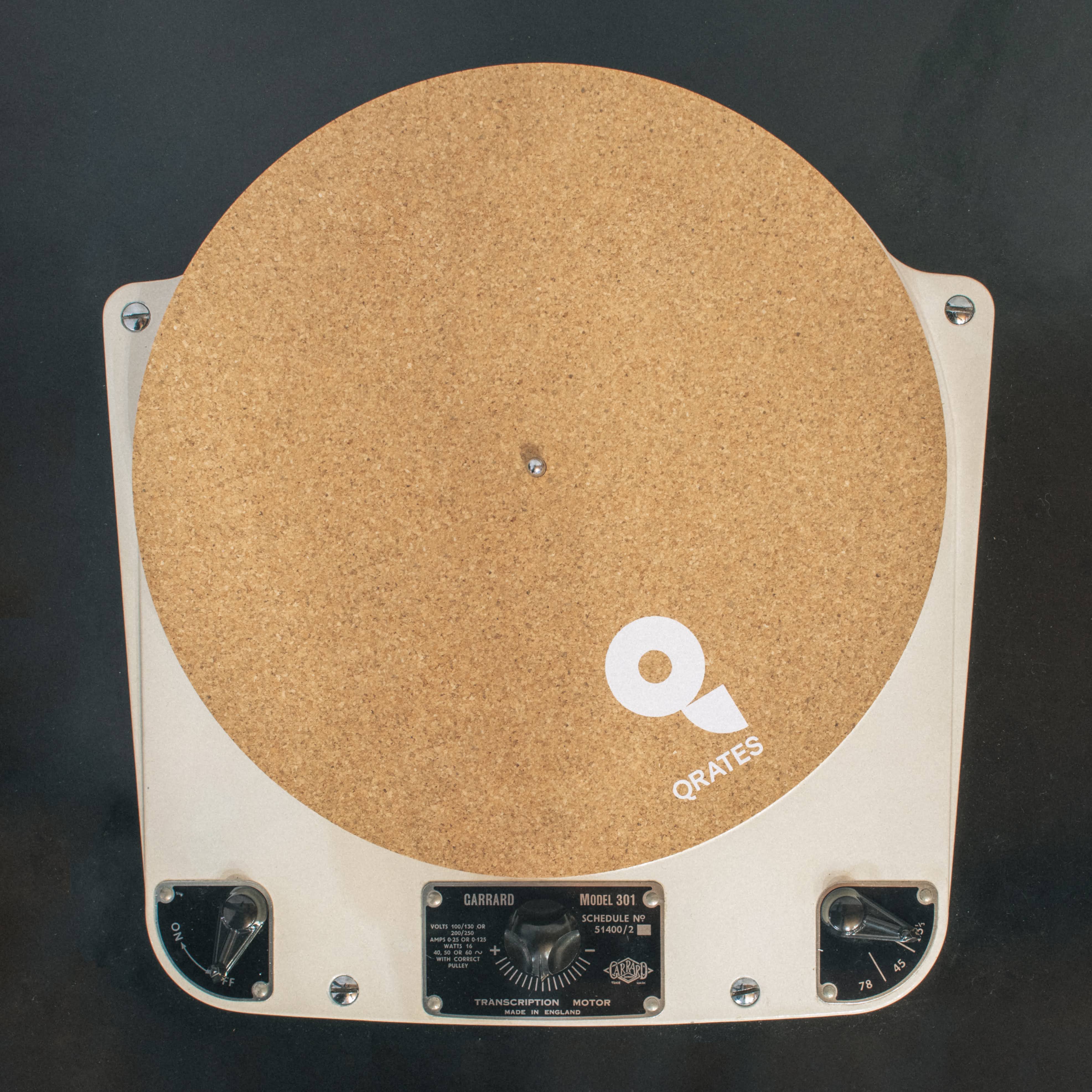
Crowdfunding is becoming a useful tool for artists to facilitate releases these days, how is this integrated into Qrates process?
Crowdfunding via Qrates is one way to finance production costs. You can also simply pay for costs up front and take orders while your record is in production too. The beauty of the crowdfunding option is not only in the fact that the artist has zero upfront financial risk, but also 2 more things. Firstly, your record is pressed to order; meaning there is no over or under ordering. Every fan that ordered your record can get a copy without you having to “best guess” the number of records to press only to have boxes of inventory lying around. Secondly, crowdfunding projects have a set duration. This creates an event. Fans can participate in this event and take home a beautiful product at the end. It’s a great way to create engagement around a release and also super limited editions of a physical product.
What are your future aspirations for Qrates?
There are many, but ultimately, we want to keep innovating in the space for music on physical, both for the independent artist and label. One recent update is, we’re now offering cassettes on Qrates. Can’t wait to see another world of artists on Qrates for sure.
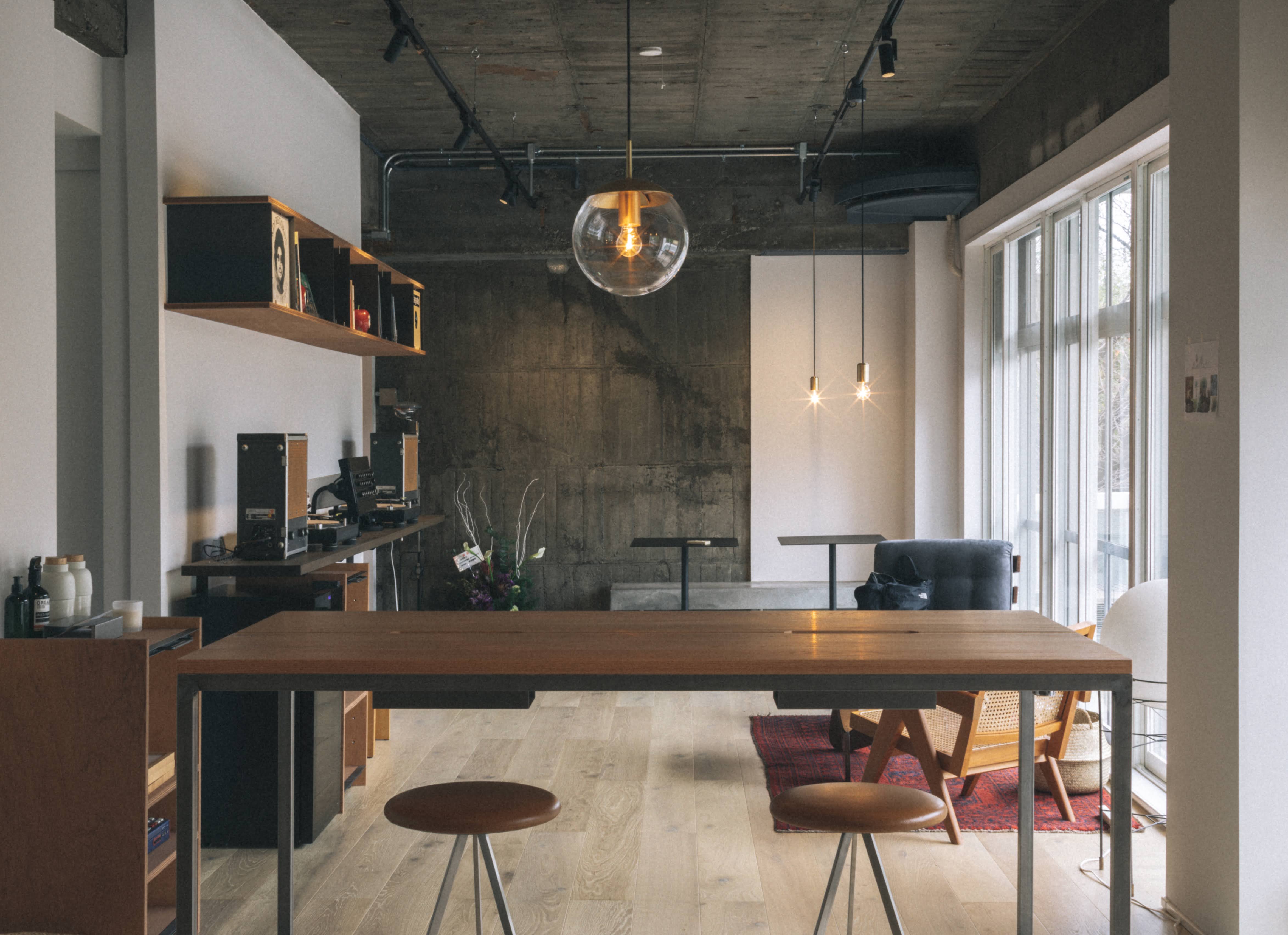
Thanks so much to Taishi for chatting with us about his endeavours in music as well as his involvement with Qrates. It’s so exciting to see the direction that Qrates is taking with the primary focus being physical vinyl release, especially in the current musical climate for independent artists.
If you are looking to do a physical release soon, Qrates are currently offering 10% off of vinyl and cassette manufacturing costs until November 10th with the code MAKEA10
We really look forward to catching up again soon.
At Ten87 Studios we offer long term studio hire and day hire music studios. Each recording studio is acoustically treated and sound proofed to optimise any type of audio recording and music production. We are home to a large community of musicians, producers, engineers and audio professionals working in the music industry. Our main day hire studio is a world class tracking facility equipped with the best in recording studio gear, instruments, outboard and backline. We’re based in Seven Sisters, Tottenham with easy transport links to the city centre – ideal for anyone looking for a London recording studio.